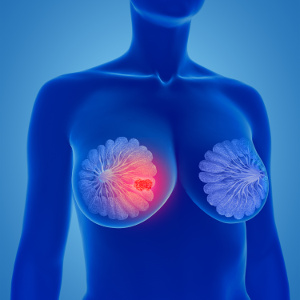Breast cancer: More selenium in the blood improves survival
 Breast cancer is the leading cancer form among women. Even though treatments have gotten a lot better the disease still has a high death toll. A Swedish-German study shows that having low levels of selenium in the blood worsens the prognosis, whereas having a higher selenium content in the blood can increase the odds of surviving breast cancer. Unfortunately, selenium deficiency is rather common in Europe. According to the scientists behind the new study, measurements of selenium status can be used to optimize blood levels of the nutrient, thereby improving treatment correspondingly.
Breast cancer is the leading cancer form among women. Even though treatments have gotten a lot better the disease still has a high death toll. A Swedish-German study shows that having low levels of selenium in the blood worsens the prognosis, whereas having a higher selenium content in the blood can increase the odds of surviving breast cancer. Unfortunately, selenium deficiency is rather common in Europe. According to the scientists behind the new study, measurements of selenium status can be used to optimize blood levels of the nutrient, thereby improving treatment correspondingly.
An increasing number of women contract breast cancer. In 2020 alone, 685,000 people worldwide died of the disease despite improved treatments. In many people who have completed their treatment course and are declared healthy the cancer returns. We therefore need new therapies with a long-term effect. Doctors normally look at the size and type of the tumor and inspect the attacked lymph nodes before making a prognosis. It appears now that measuring a patient’s selenium status may provide an even better picture.
Selenium supports more than 25 different proteins (selenoproteins) that help control thyroid hormones, cellular energy turnover, and cell growth. Selenium also supports some extremely powerful antioxidants called GPX (GPX 1-6). That way, the selenoproteins contribute to the metabolic processes in cells, while protecting the cells against damage, unwanted cell division, and cancer. The selenoproteins are all involved in a complicated metabolic system, and it is common practice to measure levels of one specific selenoprotein, selenoprotein P, and use it as a marker of the body’s overall selenium status.
More selenium means better cancer protection
Scientists from the University of Lund in Sweden conducted the new study in collaboration with scientists from different universities in Germany. They analyzed blood samples from 1,996 patients (eight of them were male), all of whom had just been diagnosed with primary invasive breast cancer. The researchers looked closer at blood levels of selenoprotein P, GPX-3, and total selenium. They carefully studied three selenium markers which is quite unusual.
The study revealed that the quintile with the highest points for these three selenium markers had a 50 percent greater chance of surviving their disease after eight years compared with the quintile with the lowest selenium marker score.
In other words, patients with higher selenium levels in the blood had the highest degree of protection against their cancer and the lowest risk of dying.
The scientists behind the new study say that measuring blood levels of selenium could be used to optimize selenium status, thereby improving the long-term effect of treatments.
The selenium-containing GPX antioxidant protects against oxidative stress and relapse
Oxidative stress is an imbalance between free radicals and antioxidants. On the one hand, free radicals are essential because they are involved in a host of different metabolic processes. On the other hand, they are highly reactive molecules that can turn into a threat and attack cells and tissues if things get out of control. The free radical burden is worsened by factors like stress, overweight, smoking, ageing, and poisoning. Our only protection against free radicals and oxidative stress is the presence of various antioxidants. Here, GPX is particularly vital because it represents the cells’ first line of defense.
The scientists observed that the risk of a relapse after breast cancer therapy went up if blood levels of GPX-3 were low. They also tell that breast cancer is normally associated with oxidative stress caused by free radicals.
The new Swedish-German study is published in Redox Biology and supports an earlier Polish study that showed a link between higher blood selenium levels and increased chances of surviving breast cancer after 10 years.
It is generally important to make sure go have sufficient levels of selenium in the blood throughout life for many different reasons.
Selenium deficiency is widespread in Europe, but we can compensate for that
There is widespread selenium deficiency in Europe, mainly because of nutrient-depleted farmland. The deficiency is reflected throughout the entire food chain. As mentioned earlier, selenoprotein P is used as a marker for levels of selenium in the blood, and studies show that it takes around 100 micrograms of selenium daily to properly saturate this useful selenoprotein. In other words, it takes more than the recommended intake level for selenium (55 micrograms per day in Denmark). Selenium yeast with a variety of many different selenium sources is best for supplementation because it delivers a wide spectrum of selenium types like you would get from eating a balanced diet. Several selenium studies have been conducted with a daily dose of 200 micrograms (as selenium yeast). The European Food Safety Authority (EFSA) has established a safe upper intake level of 300 micrograms daily for selenium.
References:
Kamil Demircan et al. Serum selenium, selenoprotein P and glutathione peroxidase 3 as predictors of mortality and recurrence following breast cancer diagnosis: A multicentre cohort study. Redox Biology, November, 2021
Mark Szwiec et al. Serum Selenium Level Predicts 10-Year Survival after Breast Cancer. Nutrients, March, 2021
Lutz Shomburg. Dietary Selenium and Human Health. Nutrients 2017
New Links between selenium and cancer prevention. HRB. December 2017
Search for more information...
- Created on .








